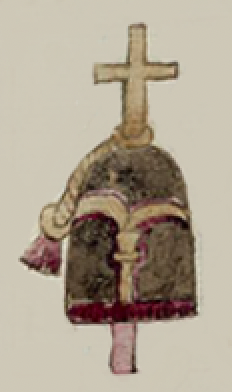petlacotl (CST19)
This is a painting of the simplex glyph for the term manga cruz petlacotl, which includes two loanwords from Spanish. The petlacotl is a decorated ritual device) shows a frontal view of a tall Christian cross with a black textile “sleeve” (manga is the Spanish loanword for this) covering the lower part of the cross (cruz), under the crossbar. Petlacotl is a Nahuatl term for a ritual device or religious ornament. The petlacotl typically had feathers on it. It could take the shape of a “tree” that was decorated with all kinds of embellishments, which may have some association with this decoration of a cross. The companion Nahuatl text explains that this cross with its covering was present at burials.
Stephanie Wood
For the transcription and translation of this section of the Codex Sierra, see Kevin Terraciano’s study (2021), pp. 113, 148. At the time of the creation of this particular record (October 2024), this is a one-of a kind hieroglyph. Crosses in this collection typically appear on top of churches or in public squares, such as marketplaces. One personal name that is interesting is a broken cross (see below).
Stephanie Wood
1550–1564
Jeff Haskett-Wood
mangas, cubiertas, envolturas, cruces, feathers, plumas

manga, sleeve (a loanword from Spanish taken into Nahuatl), https://nahuatl.wired-humanities.org/content/manga
cruz, Christian cross (a loanword from Spanish taken into Nahuatl), https://nahuatl.wired-humanities.org/content/cruz
petlaco(tl), a feather-covered ornament or ritual device, https://nahuatl.wired-humanities.org/content/petlacotl
manga cruz devisa ritual
Stephanie Wood
Códice Sierra-Texupan, plate 19, page dated 1558. Origin: Santa Catalina Texupan, Mixteca Alta, State of Oaxaca. Kevin Terraciano has published an outstanding study of this manuscript (Codex Sierra, 2021), and in his book he refers to alphabetic and “pictorial” writing, not hieroglyphic writing. We are still counting some of the imagery from this source as hieroglyphic writing, but we are also including examples of “iconography” where the images verge on European style illustrations or scenes showing activities. We have this iconography category so that such images can be fruitfully compared with hieroglyphs. Hieroglyphic writing was evolving as a result of the influence of European illustrations, and even alphabetic writing impacted it.
https://bidilaf.buap.mx/objeto.xql?id=48281&busqueda=Texupan&action=search
The Biblioteca Digital Lafragua of the Biblioteca Histórica José María Lafragua in Puebla, Mexico, publishes this Códice Sierra-Texupan, 1550–1564 (62pp., 30.7 x 21.8 cm.), referring to it as being in the “Public Domain.” This image is published here under a Creative Commons license, asking that you cite the Biblioteca Digital Lafragua and this Visual Lexicon of Aztec Hieroglyphs.


